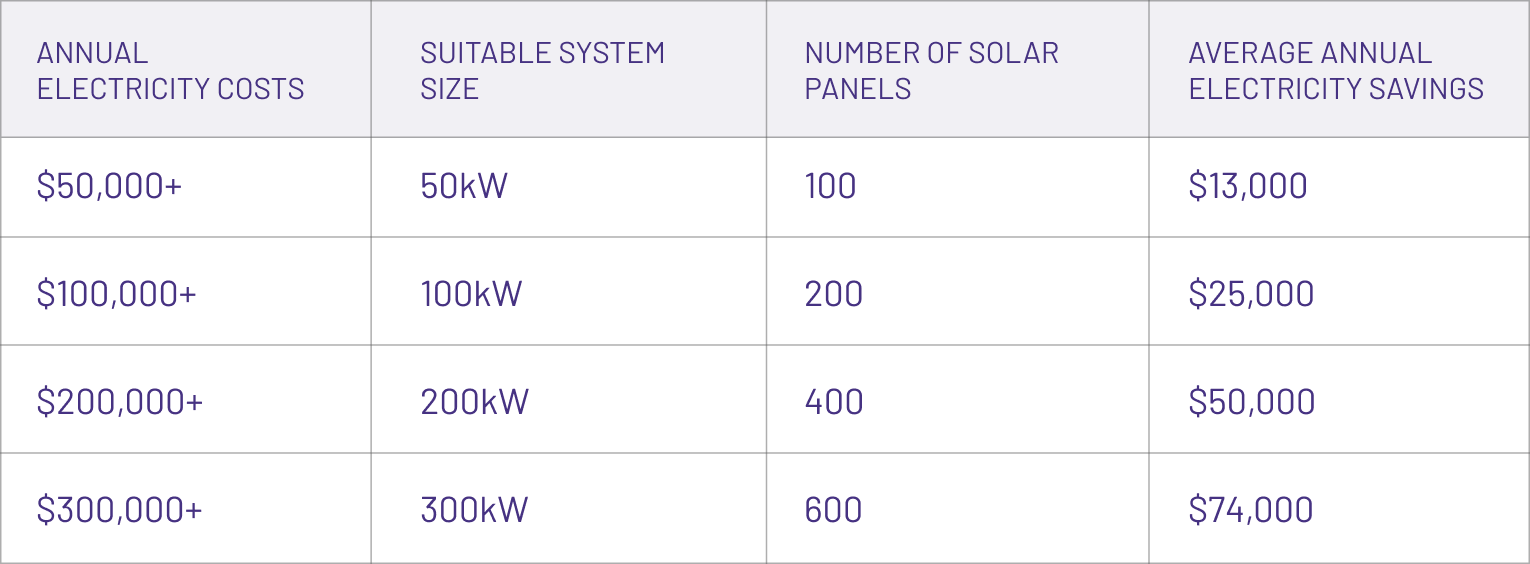Researching commercial solar system size and options can be a daunting task. Traditional rooftop and ground mount panels, solar car shades, integrated designs and alternative models like Power Purchase Agreements - there’s a vast number of options to consider, and there is no one-size-fits-all approach to suit every business.
However, understanding your energy requirements will give you the best chance at integrating a cost-effective and efficient solar system into your business.
In this article, we outline the steps we follow to determine what size solar panels and system any business needs, and review some of the different options worth considering for larger commercial organisations.
Understanding Your Energy Needs
First and foremost, you need an accurate understanding of how much energy your business uses, and whether that consumption is likely to grow in the future. To get the best value for money, you should aim to use all of the power that your solar system can generate. This will save you from exporting any excess power to the grid - an option which is no longer worthwhile, given the low feed-in tariffs available today.
One common method of calculating your solar needs is to average your minimum daily load, which is usually around midday, over the course of seven days. This can give you a good indication of the system size you require. The table below provides a rough guide to calculating your solar system size based on your annual commercial energy costs:

What Size Commercial Solar Systems Are Available?
Commercial solar systems generally fall into three size categories:
Solar Systems under 30 kW
Solar systems under 30 kW are the smallest tier of commercial installation, which can usually be completed by residential installers. These can generate around 120 kWh of power daily and do not require the installation of a Grid Protection Unit, which adds a significant cost to the system.
Solar Systems between 30 kW and 100 kW
30-100 kW solar systems are mid-sized installations that are often seen on medium-sized offices, clubs and retail shops. Unlike systems 30 kW and under, these mid-sized systems need a commercial solar specialist and extra components required by the network.
Solar Systems over 100 kW
Larger office buildings, mid-sized factories and hotels are common beneficiaries of solar systems over 100 kW. These larger systems require special meters to claim LGC rebates and come with added complexities.
Solar Systems over 250 kW
Systems of this size are substantial projects, such as large solar farms, shopping centres and large factories. At Smart Commercial Solar, our typical installation falls into this category, and can even be as large as 15 MW+.
Commercial Solar Options
Now that we’ve outlined how to calculate the size of the solar system you need, let’s look into some of the various types of installations available to commercial businesses.
Rooftop
Rooftop solar systems are some of the most popular solar PV systems because they’re safe to install, easy to maintain and cause minimal disruption to business operation during installation.
At Smart Commercial Solar, we’ve installed over 1700 rooftop solar systems across Australia for businesses as diverse as Bunnings Warehouse, Darrell Lea and Carlton United Breweries.
Ground Mount
Ground mount solar systems are a great way to turn unusable pieces of land into productive energy sources, especially if your roof structure is unsuitable for a rooftop system. Ground mount systems are also easy to operate and maintain.
Solar Car Shades
Where solar was previously seen as something to retrofit, solar car shades are an intelligent use of space that can deliver multiple benefits in a single form, including providing clean energy to adjacent buildings. These systems can also be modular and adaptable to suit any car park size.
Building Integrated
Building-integrated solar systems take this intelligent design approach to the next level, incorporating solar into the architectural structure such as replacement roofs.
Power Purchase Agreements (PPAs)
If your commercial business is considering a solar system, it’s worth noting the benefits that solar Power Purchase Agreements (PPAs) can provide. Rather than owning, maintaining and operating a solar system, PPAs allow you to simply purchase the power that the system generates.
PPAs are popular alternative finance option for larger companies who have strong commitments to sustainability, yet do not have the physical space to install large solar systems. In essence, a PPA delivers all of the environmental benefits of solar energy, with none of the operational risks that come with installing and maintaining your own system.
If you’d like to learn how Smart Commercial Solar can assist your business transition to cleaner, more cost-effective energy, get in touch with us today.




